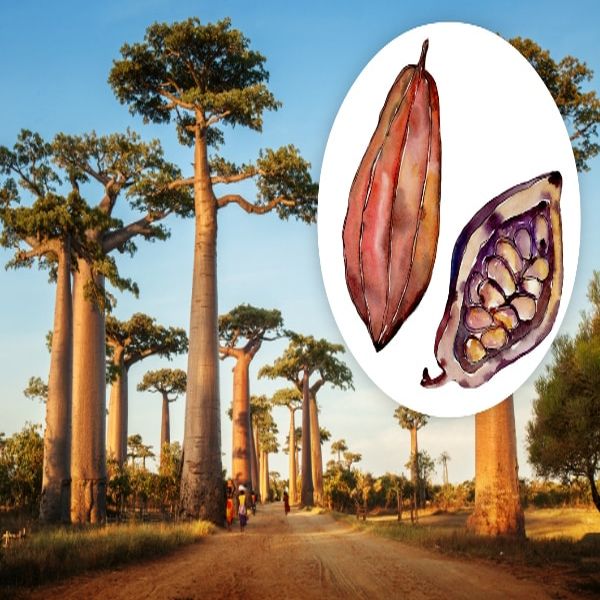The baobab tree is the “old man” of the plant kingdom, generally living 4,000 to 6,000 years. The magnificent tree, with fruit as big as a football and sweet and juicy, is a favorite food of monkeys and orangutans.Baobab is native to tropical Africa, from the African continent, the Mediterranean Sea, the Atlantic ocean and the Indian Ocean islands, to the north of Australia, baobab can be seen, in China’s fujian, guangdong, yunnan in the tropical areas of a small number of cultivation. Madagascar’s murondawa region on the Indian Ocean, home to most of the world’s breadfruit species, is the most popular baobab viewing spot.
Baobab is the exceptional superfruit of Africa’s ‘Tree of Life’. This kind of tree is popular all over the world because of its rich nutrition. These giant trees support wildlife and even the communities around them, and their 3-pound fruit can serve as a health-enhancing powder with many benefits.The fruit of the baobab tree is nutritious and rich in vitamin C, calcium and potassium. The baobab meal comes from the dry flesh of the tree fruit, which resembles the coconut and has a mild citrus flavour.
Because it is one of the world’s most nutrient-dense foods, the baobab fruit is rich in vitamins, antioxidants and fiber. And every part of the tree is valuable, including the leaves, which are a nutrient-rich vegetable, and the baobab meal from the fruit is especially effective. It contains six times as much vitamin C as an orange. It provides a great deal of calcium, phosphorus, and potassium for the immune system, skin, bones, mood, and energy levels.
Baobabs are believed to relieve many of the body’s mild symptoms and fight diarrhea. Some of these benefits have also been studied to compete with traditional medicines, such as aiding recovery from diarrhea-induced dehydration.
The high fiber content of the baobabs helps balance the digestive system, helps a person maintain a healthy weight, helps maintain a healthy heart, and even lowers blood sugar spikes. The baobabs are made up of 50 percent fiber and provide 6 grams of fiber at a time. Since many americans cannot meet the recommended fiber intake, daily use of baobabs can help a person maintain a healthy level of fiber intake.
Despite a general understanding of the importance of probiotics, many people do not consider them in their diets. Without enough probiotic fiber, the probiotic bacteria in your gut may not thrive. Provide your body with plenty of prebiotic foods that improve the functioning of your digestive system. Gut health also AIDS the immune system, heart and joints. When the body’s main waste-disposal organ performs its highest function, the incidence of many diseases may be reduced.
Baobabs are also a great source of antioxidants, with twice as much as goji berries. Antioxidants reduce oxidative stress in human cells and help scavenge free radicals. That said, if people simply get their source of antioxidants from a form of supplement, it may be possible to use this nutrient to fight free radicals in their bodies. By consuming antioxidants from food, individuals can avoid potential health risks and enjoy the tremendous benefits of antioxidants, including slowing down the aging process.
There are many simple, convenient and delicious ways to use baobab flour. The fruit has a strong tropical flavour with sweet citrus notes. It naturally blends well with other fruits in recipes. It can also be added to almost anything, and its mild taste makes it a good addition to many recipes.
Baobab powder can be sprinkled on fruit, cereal, or yogurt for breakfast. It adds extra flavor to porridge and oatmeal, and it energizes you in the morning. Those who enjoy baking should try adding it to cakes, cookies or breads for an extra healthy dose of fiber. This is a great way for a person to add more healthy nutrients to his or her family’s favorite foods. For dinner, it can be added to soups or sauces as a thickener. Baobab flour can even be used as a salad dressing to bring the salad to another healthy level.
Those who prefer simplicity can add it to hot water, coconut water or milk. Even fruit juice is an excellent foundation for baobab flour. Alternatively, incorporate ground baobabs into your daily snack recipes to provide energy or granola nutrition bars.
Post time: Apr-10-2020
